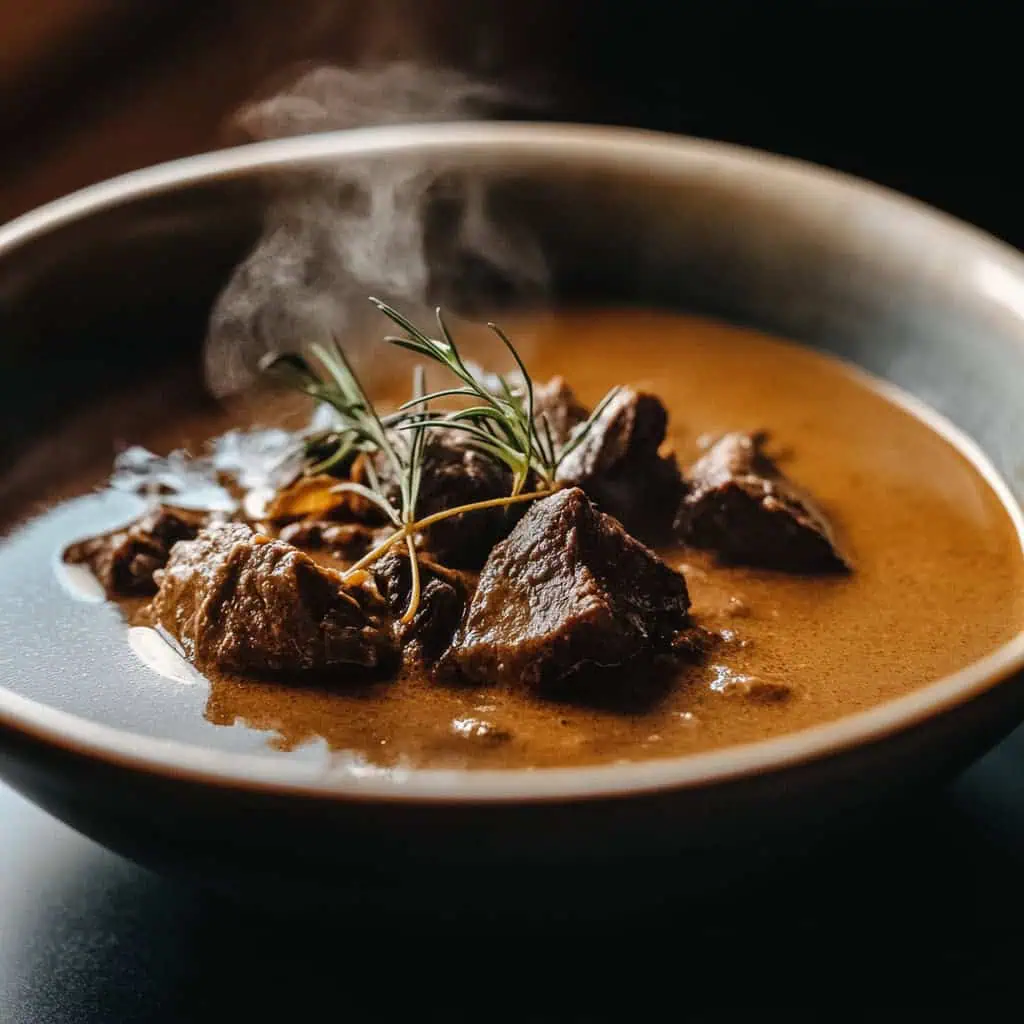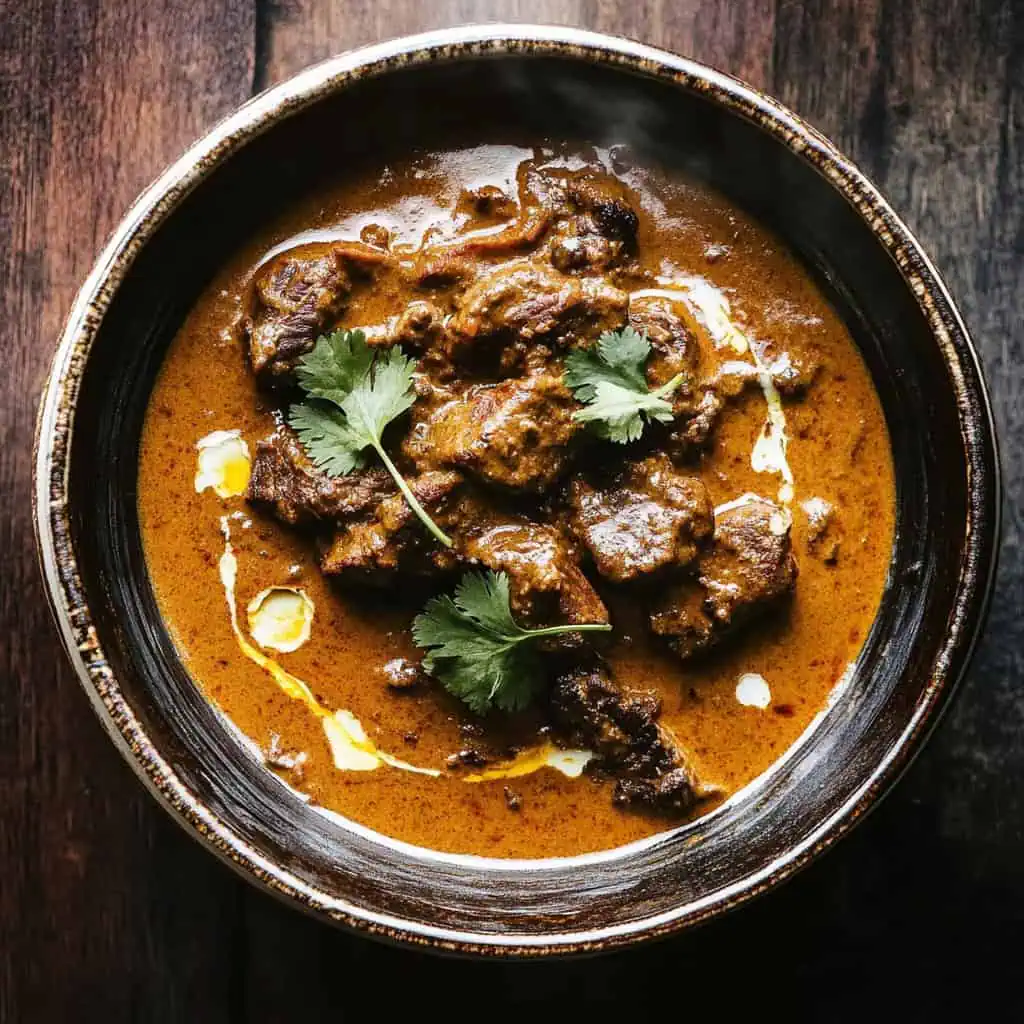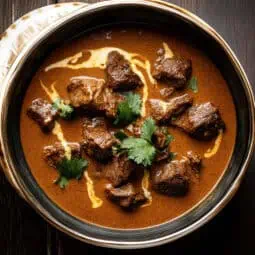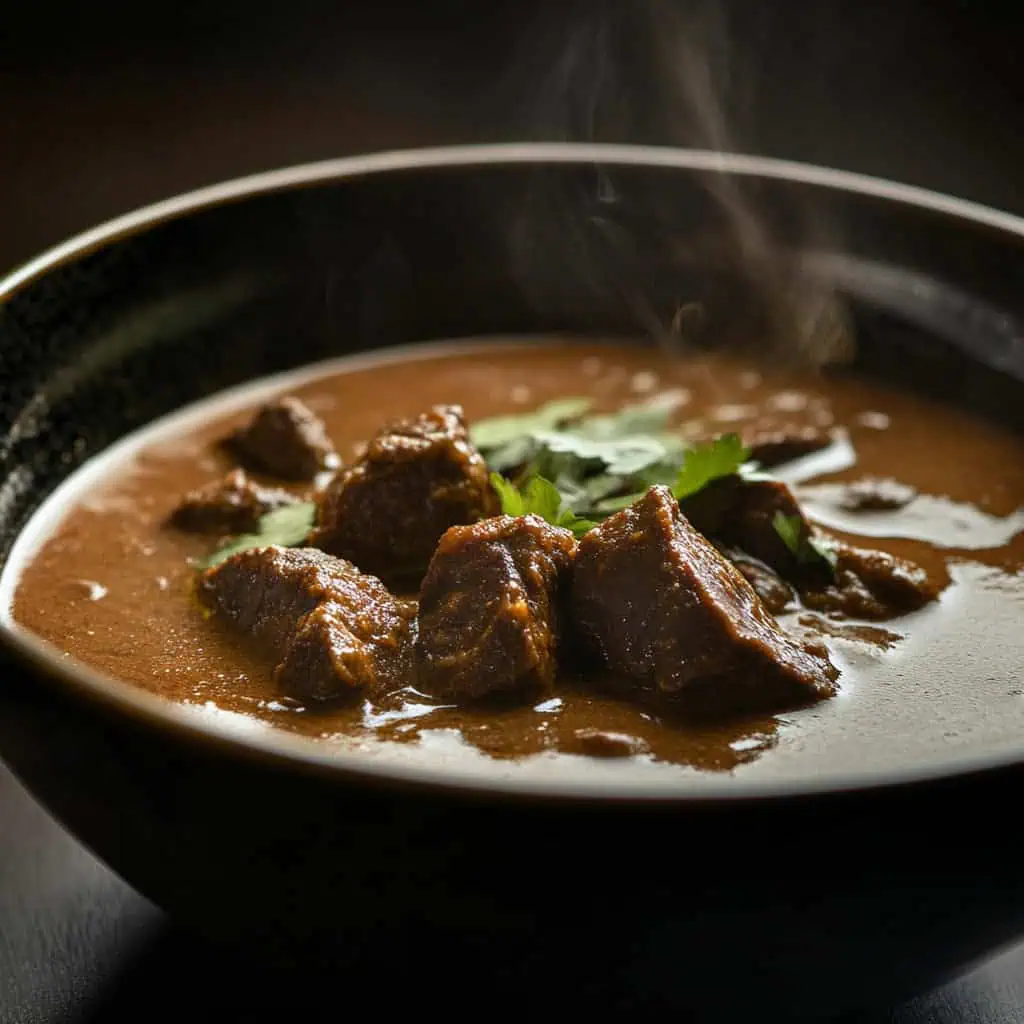I first discovered Tausug Beef Kulma during an unforgettable trip to Zamboanga City, where I wandered into a small, family-run eatery tucked away in the bustling streets near the marketplace. The aroma of curry spices and coconut milk drew me in, and I found myself sitting next to locals who were enthusiastically enjoying this rich, mahogany-colored curry.
The owner, a warm Tausug grandmother, noticed my curiosity and proudly explained how this dish was a treasured recipe passed down through generations in her family. As I savored each spoonful of the tender beef swimming in that velvety, nutty sauce, she shared how the dish reflects the beautiful blend of Filipino and Malaysian influences in Mindanao cuisine. She revealed her secret - patience in slow-cooking and the perfect balance of peanut butter and coconut milk.
This recipe is my homage to that memorable afternoon and the generous spirit of the Tausug people who shared their culinary heritage with a curious traveler.
Jump to:

Why You'll Love This Recipe
- Tender, melt-in-your-mouth beef chunks in a velvety curry sauce
- Perfect balance of coconut, curry, and peanut flavors
- Make-ahead friendly and tastes even better the next day
- A showstopping dish for special occasions
- Rich in protein and healthy fats
- Naturally gluten-free
Ingredients
Each ingredient in Tausug Beef Kulma serves a specific purpose in creating its distinctive flavor profile. The curry powder, cinnamon, and paprika form a warm spice base that infuses the beef during marination.
Coconut milk and cream provide richness and silky texture, while peanut butter adds unique nuttiness and helps thicken the sauce. Lemongrass and bay leaf contribute aromatic notes, while tomato paste adds depth and subtle acidity. Birds eye chilies introduce gentle heat that balances the richness.
Together, these ingredients represent the perfect marriage of South Asian curry traditions with Filipino ingredients, creating a dish that's both comforting and complex.

For the Marinade:
- 1 kg stewing beef, cut into 2-inch cubes
- 2 tablespoons curry powder
- 1 teaspoon cinnamon
- 1 teaspoon paprika
- Juice from half lemon (kalamansi can be substituted)
- Salt to taste
For the Curry:
- 2 cups coconut milk
- ½ cup coconut cream
- 2 ½ cups beef stock
- 2 heaping tablespoons peanut butter
- ⅓ cup tomato paste
- 4 cloves garlic, minced
- 2 large onions, chopped
- 2 birds eye chilies, chopped
- 1 bunch lemongrass, pounded
- 1 piece bay leaf
- Salt and freshly ground black pepper to taste
- Oil for cooking
Equipment
- Large heavy-bottomed pot (kaldero) - For even heat distribution and preventing burning of the delicate spices and coconut milk
- Sharp knife (kutsilyo) - For cutting meat into even chunks to ensure consistent cooking
- Wooden Spoon (Sandok Kahoy) - For gentle stirring without scratching the pot and breaking up the sauce
- Measuring cups and spoons (Panukat) - For accurate measurements of spices and liquids
- Mortar and pestle (dikdikan) - For pounding lemongrass to release its essential oils
- Large mixing bowl (mangkok) - For marinating beef evenly with spices

How To Make
- In a large bowl, mix your curry powder, cinnamon, paprika, lemon juice, and salt. Add your beef cubes and mix well, making sure each piece is coated with the spices. Let this sit for 30 minutes to allow the flavors to penetrate the meat.
- Heat oil in a large pot over medium-high heat. Once hot, add your marinated beef pieces in small batches and brown them until they're golden on all sides - about 3-4 minutes per side. Take out the beef and set aside on a plate. Working in batches prevents overcrowding which would steam rather than brown the meat.
- Using the same pot, turn down the heat to medium. Add garlic and cook until fragrant, about 30 seconds. Add your chopped onions and cook until translucent and soft, about 5 minutes.
- Return the browned beef to the pot and add the bay leaf. Pour in your beef stock and coconut milk. Bring to a boil, then lower the heat, cover the pot, and let it simmer gently for 1 hour, stirring occasionally to prevent sticking.
- After an hour, add your tomato paste, peanut butter, lemongrass, and chilies. Continue cooking on low heat for 45 minutes, or until the meat is fork-tender.
- Pour in the coconut cream and cook for 15 more minutes, stirring gently. Taste the sauce and adjust seasoning with salt and pepper if needed. Turn off the heat and let it rest for 15 minutes - this resting period allows the flavors to meld beautifully.
- Your Beef Kulma should now have a rich, creamy sauce that's thick enough to coat the back of a spoon. Serve hot with steamed rice.

Tips from Lola's Kitchen
- Choose the right cut of beef - Chuck, brisket, or shank work best as they become tender and flavorful with slow cooking
- Toast your spices first - For deeper flavor, lightly toast the curry powder and spices in a dry pan before mixing with other marinade ingredients
- Don't rush the browning - Properly browned meat creates a foundation of flavor that carries throughout the dish
- Layer your flavors - Add ingredients at different cooking stages to create complex flavor profiles
- Pound lemongrass thoroughly - Bruising it releases essential oils that infuse the curry with aromatic citrus notes
- Add coconut cream at the end - This prevents it from separating during the long cooking process
- Simmer, don't boil - Gentle heat ensures tender meat and a smooth, unbroken sauce
- Let it rest before serving - Like a good stew, Kulma benefits from a 15-minute rest to allow flavors to settle
Substitutions
- Beef → Lamb or goat meat - Both work wonderfully and are traditional variations
- Peanut butter → Ground roasted peanuts - Use ¼ cup for a more rustic texture and flavor
- Birds eye chilies → Regular red chilies or chili flakes - Adjust according to your heat preference
- Fresh lemongrass → 2 tablespoons lemongrass paste - An acceptable substitute when fresh is unavailable
- Coconut milk → Combine 1 part coconut cream with 1 part water - In a pinch, but fresh is always best
- Beef stock → Chicken stock or water with beef bouillon - Provides similar savory depth
- Cinnamon → ½ teaspoon garam masala - Offers similar warming notes with added complexity
Troubleshooting
- Meat is tough - Continue cooking on low heat. Tough meat simply needs more time to break down collagen
- Sauce is too thin - Simmer uncovered for 15-20 minutes to reduce, or add 1 tablespoon of cornstarch mixed with water
- Sauce is too thick - Add warm beef stock or water in small increments until desired consistency is reached
- Too spicy - Add more coconut cream to mellow the heat, or serve with a side of yogurt
- Not spicy enough - Add freshly chopped chilies or a dash of red pepper flakes
- Sauce splits or curdles - Lower heat immediately and gently stir in a tablespoon of coconut cream
- Tastes bland - Balance with salt, a squeeze of lemon juice, or a dash more curry powder
Storage & Reheating
- Refrigerate: Store in an airtight container for up to 4 days. The flavor actually improves after a day as the spices continue to meld.
- Freeze: Kulma freezes beautifully for up to 3 months. For best results, freeze without the coconut cream and add it when reheating.
- Thawing: Thaw overnight in the refrigerator for best texture and flavor preservation.
- Reheating: Warm gently over low heat on the stovetop, adding a splash of water or stock if needed to loosen the sauce. Avoid high heat which can cause the sauce to separate.
- Make ahead: This dish is perfect for preparing 1-2 days ahead of serving for special occasions, as the flavors continue to develop.

FAQ
What's the difference between Kulma and Korma?
While similar in concept, Kulma uses peanuts and has a distinct Filipino-Muslim influence with local ingredients like lemongrass, while traditional Indian Korma typically uses cashews or almonds and a different spice profile.
Can I make this less spicy for children?
Absolutely! Reduce or omit the birds eye chilies, and you'll still have a flavorful dish that's family-friendly.
Why isn't my sauce thickening?
Simmer uncovered for the last 15-20 minutes to reduce the sauce. The peanut butter should also help thicken it naturally.
Can I use a pressure cooker or Instant Pot to speed up the cooking time?
Yes! Cook under high pressure for 35 minutes with a natural pressure release for equally tender results. Add the coconut cream after pressure cooking.
What side dishes pair well with Beef Kulma?
Traditional accompaniments include steamed white rice, roti, pickled vegetables like achara, or a fresh cucumber salad to balance the rich curry.
Can I use regular milk instead of coconut milk?
No, coconut milk is essential for authentic flavor and texture. It provides the signature creaminess and slight sweetness that defines the dish.
Is this dish always spicy?
The heat level is customizable. Traditional Tausug Kulma has a moderate spice level, but you can adjust according to your preference.
Can I add vegetables to this dish?
While not traditional, potatoes, carrots, and bell peppers make excellent additions. Add firmer vegetables with the tomato paste and softer ones in the last 20 minutes of cooking.
Related
Looking for other recipes like this? Try these:

Tausug Beef Kulma (Kulma Sapi)
Equipment
- Large heavy-bottomed pot (kaldero) For even heat distribution and preventing burning
- Sharp knife (kutsilyo) For cutting meat and vegetables
- Wooden Spoon (Sandok Kahoy) For stirring without scratching the pot
- Measuring cups and spoons (Panukat) For accurate measurements
- Mortar and pestle (dikdikan) For pounding lemongrass
- Large mixing bowl (mangkok) For marinating beef
Ingredients
For the Marinade:
- 1 kg stewing beef karne ng baka, cut into 2-inch cubes
- 2 tablespoons curry powder pulbos na curry
- 1 teaspoon cinnamon kanela
- 1 teaspoon paprika
- Juice from half lemon kalamansi can be substituted
- Salt asin to taste
For the Curry:
- 2 cups coconut milk gata
- ½ cup coconut cream kakang gata
- 2 ½ cups beef stock sabaw ng baka
- 2 heaping tablespoons peanut butter mantika ng mani
- ⅓ cup tomato paste pino ng kamatis
- 4 cloves garlic bawang, minced
- 2 large onions sibuyas, chopped
- 2 birds eye chilies siling labuyo, chopped
- 1 bunch lemongrass tanglad, pounded
- 1 piece bay leaf dahon ng laurel
- Salt and freshly ground black pepper to taste
- Oil for cooking
Instructions
- First grab a large bowl and mix your curry powder, cinnamon, paprika, lemon juice, and salt. Add your beef cubes and mix well, making sure each piece is coated with the spices. Let this sit for 30 minutes.
- Heat oil in a large pot over medium-high heat. Once hot, add your marinated beef pieces in small batches and brown them until they're golden on all sides - about 3-4 minutes per side. Take out the beef and set aside on a plate.
- Using the same pot, turn down the heat to medium. Add garlic and cook until you can smell its aroma, about 30 seconds. Add your chopped onions and cook until they turn clear and soft, about 5 minutes.
- Put the browned beef back in the pot and add the bay leaf. Pour in your beef stock and coconut milk. Let it come to a boil, then lower the heat, cover the pot, and let it simmer gently for 1 hour. Give it a stir now and then.
- After an hour, add your tomato paste, peanut butter, lemongrass, and chilies. Keep cooking on low heat for 45 minutes, or until the meat is so tender it breaks apart easily with a fork.
- Pour in the coconut cream and cook for 15 more minutes, stirring gently. Taste the sauce and add salt and pepper if needed. Turn off the heat and let it rest for 15 minutes - this helps all the flavors come together nicely.
- Your Beef Kulma should now have a rich, creamy sauce that's thick enough to coat the back of a spoon. Serve hot with steamed rice and enjoy!
- Remember: Don't rush the cooking time - this is what makes the beef tender and the sauce rich and flavorful. If the sauce gets too thick while cooking, you can add a splash of water or beef stock.
Tips from Lola's Kitchen
- Choose beef chuck or brisket for the best results
- Pound lemongrass well to release its essential oils
- Don't rush the cooking process - slow cooking ensures tender meat
- Add coconut cream at the end to prevent curdling
- Let it rest for 15 minutes before serving to allow flavors to meld
Nutrition
The Story Behind Tausug Beef Kulma
Deep in the heart of Mindanao, where the waters of the Sulu Sea lap against the shores of Zamboanga, a culinary treasure has been simmering in local kitchens for generations. Tausug Beef Kulma, a dish that speaks volumes about the rich tapestry of Filipino-Muslim cuisine, tells a story of cultural exchange along ancient maritime trade routes.
The origins of this beloved dish can be traced to the Tausūg people, one of the largest Muslim ethnic groups in the Philippines, who have called the Sulu Archipelago and Zamboanga Peninsula home for centuries. The name "Kulma" itself bears a striking resemblance to the Indian "Korma," hinting at the historical spice trade that once flourished between South Asia and the Philippine islands. This connection isn't merely coincidental – it's a delicious testament to the vibrant cultural exchanges that have shaped Mindanao's culinary landscape.
What makes Tausug Beef Kulma unique is its ingenious fusion of local and foreign ingredients. While it shares the curry foundation of its South Asian cousins, the addition of coconut milk and peanuts creates a distinctly Filipino profile. This adaptation showcases the Tausūg people's culinary ingenuity, transforming an imported dish into something uniquely their own. The use of local ingredients like lemongrass (tanglad) and birds eye chilies (siling labuyo) further cements its place in Filipino cuisine.
Today, while Kulma holds special significance during Ramadan festivities, it has transcended its religious origins to become a beloved dish throughout Zamboanga. You'll find it bubbling away in Muslim restaurants across the city, its rich aroma drawing in locals and tourists alike. Each family guards their own version of the recipe, some adding more chilies for heat, others increasing the peanut butter for richness, but all maintaining the dish's essential character – a perfect marriage of tenderness and flavor.
The dish represents more than just a meal; it's a bridge between cultures, a celebration of Mindanao's diverse heritage, and a reminder of how food can tell the story of a people's history. As you savor each spoonful of tender beef in its velvety sauce, you're tasting centuries of tradition, trade, and cultural exchange that have made Filipino cuisine the vibrant mosaic it is today.










Comments
No Comments